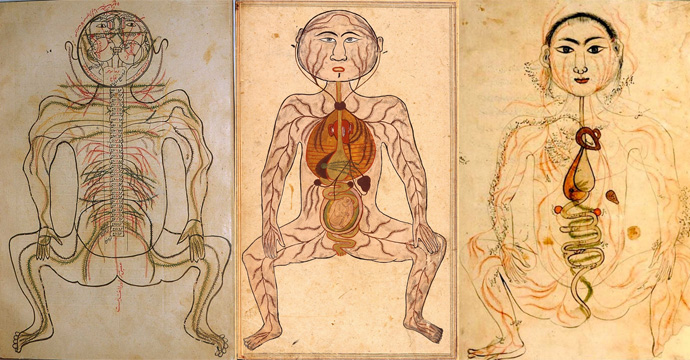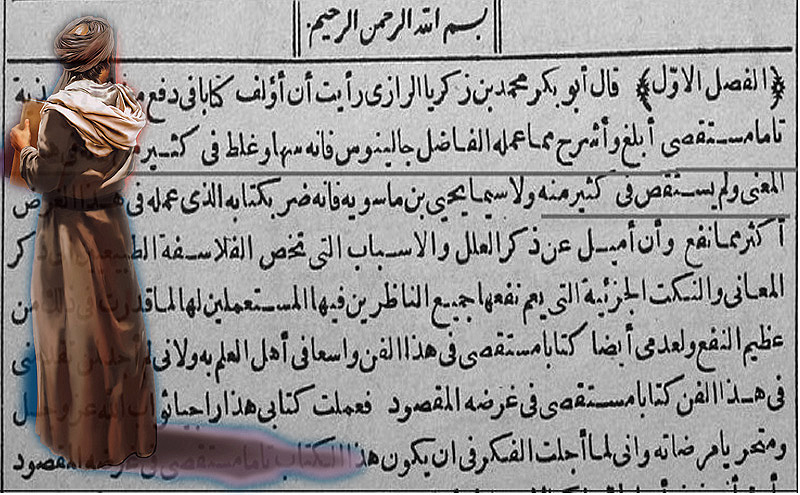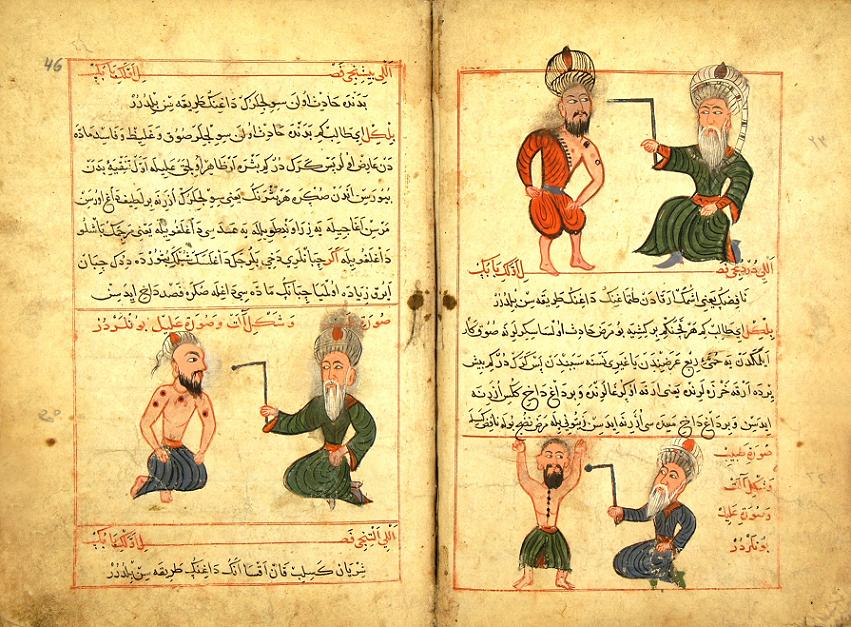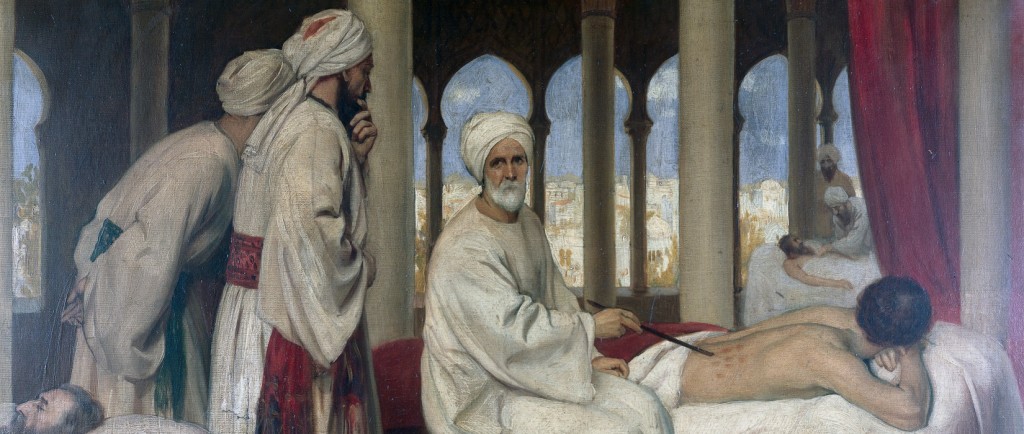If you think medical advice on healthy living – good nutrients, exercise and stress free existence is a modern medical practice, you might want to think again and join us to discover 5 medical books from 1,000 years ago that explored those exact topics.
Looking after the health and wellbeing of humans is a key experience in the development of humankind. Many civilisations have contributed to the development of healthcare and medicine, and over one thousand years ago, Muslim Civilisation had an influential role in the development of this discipline.

Similar manuscripts of work on anatomy contained illustrated chapters on five systems of the body: bones, nerves, muscles, veins and arteries. This page depicts the arteries, with the internal organs shown in watercolors
During the Golden Age of Muslim Civilisation medical care was free to all. Hospitals were built in many cities across the Muslim World, and cutting-edge treatments such as cataract operations, regular vaccinations, internal stitching, bone setting, and medical eduction in teaching hospitals were part of standard practice, as was the awareness of the importance of nutrition and exercise in maintaining life and preserving health.
 |
Medicine is a science, from which one learns the states of the human body … in order to preserve good health when it exists, and restore it when it is lacking…” 11th century Ibn Sina from his book the Canon |
Many medical scholars realised the bad effects of unhealthy eating habits and acknowledged the importance of sports, bathing, proper dieting and sleep regulation in preserving good health – concepts that have strong resemblance to the modern day preventive medicine, and ones that echo the campaigning for healthy dieting and regular movement in combating many conditions like obesity and diabetes today.
Let us explore some of the works from that era that described links between obesity and the lack of healthy habits and practices.
 |
IBN SINA’S ‘THE CANON OF MEDICINE’ BOOK
|

From Ibn Sina’s book (Source)
The Sheikh al-Ra’is Sharaf al-Mulk Abu ‘Ali al-Husayn b. ‘Abd Allah b. al-Hasan b. ‘Ali Ibn Sina, known in Latin as Avicenna and his most famous works are those on philosophy and medicine. In medicine, one of his better known books is his encyclpedic book, Al Qanun Fi Al-Tibb (The Canon of Medicine)- which was translated into Latin towards the end of the twelfth century CE, and became a reference source for medical studies in the universities of Europe until the end of the seventeenth century.
Ibn Sina devoted a section of the 3rd volume of this famous ‘Canon” to the ‘Drawbacks of excessive Obesity’ listing obesity as a disease and suggesting tearing it with hard exercise and lean foods.
www.muslimheritage.com/article/ibn-sinas-canon-medicine
 |
AL-RAZI’S ‘DIET THERAPY’ BOOK
|

From Al-Razi’s book (Source)
Mohamed ibn Zakaria Al-Razi (Rhazes, 841–926) critically assessed, in his book Al-Hawi Fit-Tibb (An Encyclopaedia of Medicine), all the available knowledge on obesity at that time. In light of his own experience and practice, he discussed the opinions of scholars who preceded him particularly in relation to the management of excessive obesity. Al-Razi documented his discussion using clinical case reports of the patients with excessive obesity he successfully treated, describing in detail the treatments he used, including diet, drugs, exercises, massage, hydrotherapy, and lifestyle changes.
Additionally, he authored a special book (Kitāb Manafiʿ al-Aghdhiyah wa-Dafʿi Madhārriha) on how to keep away the side effects of nutrients and made it more self-explanatory and comprehensive than those of his predecessors.
www.muslimheritage.com/article/experimental-medicine-1000-years-ago
 |
IBN HUBAL’S ‘SELECTIONS IN MEDICINE’ BOOK
|

From a random Arabic book on Herbal Medicine (Source)
Ibn Hubal Al-Baghdadi (1121 – 1213) was an Arab physician and scientist known primarily for his medical compendium titled Kitab al-Mukhatarat fi al-Tibb (the Book of Selections in Medicine), which was written in 1165 in Mosul in Iraq.
He reported in his work on the predisposition of “hugely obese persons” to fall ill quickly. In their management, by heavy exercises on an empty stomach, he stressed the importance of a gradually increasing schedule because an excessively obese person may put himself at risk if he starts abruptly on heavy activities.
www.muslimheritage.com/article/obesity-1000-years-ago
 |
IBN AL-NAFĪS’ ‘ART OF MEDICINE’ BOOK
|

From Ibn al-Nafīs’s Medical work (Source)
Ibn al-Nafis was the 13th-century physician ‘Alâ’ al-Dîn abu al-Hasan ‘Ali ibn abi al-Hazm al-Qarshi, born at Al-Qarsh near Damascus. He studied medicine in Damascus under the supervision of the distinguished professor Muhadhab al-Din al-Dakhwar in the Al-Nuri hospital’s medical school.
He wrote a number of works including his most famous Kitab al-Shamil fi ‘l-Sina’a al-Tibbiyya (Comprehensive Book in the Art of Medicine). In one of his other works Al Mujiz Fit-Tibb (The Concise Book of Medicine) book he reported on the association between excessive obesity and cardiovascular and cerebrovascular accidents, and with respiratory and endocrine disorders:
 |
Excessive obesity is a constraint on the human being limiting his freedom of actions and constricting his vital pneuma (vitality), which may become disordered or even vanish as air may not be able to reach it, because they frequently suffer from dyspnoea or palpitation. Also, the excessively obese person may run the risk of a fatal vessel rupture causing bleeding into a body cavity, the brain or the heart, which will lead to their sudden death.” |
www.muslimheritage.com/article/contributions-ibn-al-nafis
 |
SAMARQANDI’S ‘FOOD AND DRINK FOR HEALTHY PEOPLE’ BOOK
|

From one of the Timbuktu’s manuscripts (Source)
Najib ad-Din Abu Hamid Muhammad ibn Ali ibn Umar Samarqandi was a 13th-century Persian physician from Samarqandi. He was a prolific medical writer and expositor of medical ideas, though few details are known of his life. His most famous book was “The Book of Causes and Symptoms”, a comprehensive manual of therapeutics and pathology. The treatises were widely read and often commentaries were written on them.
In his work “The Book of Food and Drink for the Healthy People”, he defined the proper nutritive food as that which is able to replace what disintegrates off the constituent elements of the body parts.
www.muslimheritage.com/article/medicine-middle-ages-new-insights
 |
FURTHER READING |

Figures of treatment of various illnesses (Source)
www.muslimheritage.com/medicine
Some other achievements are outlined by Campbell:
 |
The Arabians raised the dignity of the medical profession from that of menial calling to the rank of one of the learned professions; they were the first to introduce systematically arranged illustrations in their medical writings, and also gave us their system of numbering which has all but replaced the cumbersome Roman numerals. They also developed the science of chemistry as applied to medicine, and considerably improved the art of dispensing by the introduction of such elegant preparations as rose and orange water. To the Arabians we owe the introduction of the idea of the legal control of qualifying examinations for admission to the medical profession, and though the idea of establishing hospitals did not originate with them, they were responsible for the establishment of a large number of these institutions…“ |
Durant makes another excellent summary of Islamic medical achievements, which he says:
 |
The Muslims established the first apothecary shops and dispensaries, founded the first medieval school of pharmacy, and wrote great treatises on pharmacology. Muslim physicians were enthusiastic advocates of the bath, especially in fevers and in the form of the steam bath. Their directions for the treatment of smallpox and measles could scarcely be bettered today. Anesthesia by inhalation was practiced in some surgical operations…. No man could legally practice medicine without passing an examination and receiving a state diploma; druggists, barbers, and orthopedists were likewise subject to state regulation and inspection. The physician-vizier Ali ibn Isa organized a staff of doctors to go from place to place to tend the sick; certain physicians made daily visits to jails; there was an especially humane treatment of the insane….“ |


